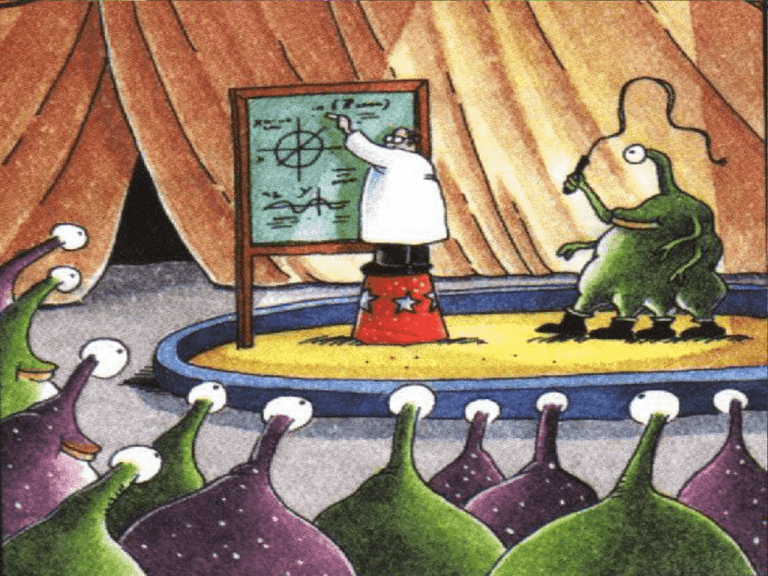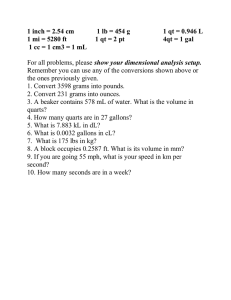19 x 10 -4 - s3.amazonaws.com
advertisement

Math for APES Calculations Without Calculators The Problem: How can you achieve success on AP Environmental Science Exams when you cannot use calculators? . Show ALL of your work and steps of calculations, even if they are so simple you think they are implied. NO WORK – NO CREDIT ! Solutions: 1. Learn to use exponents whenever numbers are especially large or small. Scientific notation is a way to express, numbers the form of exponents as the product of a number (between 1 and 10) and raised to a power of 10. For 650000 use 6.5 x 105 For 0.000543 use 5.43 x 10-4 In scientific notation remember to have one number to the left of the decimal and to use correct significant figures. Multiplication Shortcut • Remember when multiplying numbers with a lot of 0 you can cross out the O’s at the end of the numbers and add them back to the end of the answer. • 980,000,000 x 640,000 Multiply 98 x 64 AND then add 11 zero’s to the answer. SAVES TIME. 2. Practice math manipulations with exponents • When adding or subtracting numbers with exponents the exponents of each number must be the same before you can do the operation. Example: (1.9 x 10 -3) – (1.5 x 10 -4 ) = (19 x 10 -4 ) - (1.5 x 10 -4 ) = 17.5 x 10 -4 Sample exponent problem • West Freemont is a community consisting of 3000 homes. A small coal burning power plant currently supplies 12 megawatts (MW) of electricity for the town. The average household uses 8000 kWh or electrical energy per year. • a. The power plant can operate at full capacity for 8000 hrs/year, how many kWh of electricity can be produced by the plant in a year. How to get points • 1 point for correct set up. • 1 point for correctly calculating the amount of electricity generated per year. • First of all, you do NOT need to use the 3000 homes quantity. • SOLUTION: • 12 mw =12,000 Kw or 1.2 x 10 4 • 12,000 kW x 8000 hours/year = 96,000,000 kWh per/year or 9.6 x 10 7 kWh/year • B. At the current rate of electrical energy use per household, how many kWh of electrical energy does the community consume in one year? • 1 point for correct set up • 1 point for correct calculation with units. • 3000 homes x 8000 kWh/home/year = 24,000,000 kWh per year • OR 2.4 x 10 7 kWh/year 4. Keep it simple. They don’t expect you to do calculus without a calculator! 200/10000 to 20/100= 1/50 Then solve: 1/50 x 100%= 2.0% 5. Be sure to know how to convert numbers to percentages and percent change. Example: If 200 households in a town of 10,000 have solar power, what percent does this represent? 200/10000 x 100 = ? answer = 2.0% Try reducing the above fraction. Example: If a city of population 10,000 experiences 100 births, 40 deaths, 10 immigrants, and 30 emmigrants in the course of a year, what is its net annual percentage growth rate? answer = 0.40% 6. Remember that the numbers will likely be simple to manipulate. • The APES folks know you only have limited time to do 100 multiple choice and 4 essays • If you are getting answers like 1.365, then it is likely wrong 8. Show all of your units, too! Numbers given without units are often not counted even if correct. 9. Answers should make sense! LOOK them over before you finish Example: No one is going to spend 1 billion dollars per gallon of water or $10,000 per kWh electrical energy! 10. Know some basic metric prefixes for simple conversions Giga G ( MegaM( Kilo k( Hecto h Deka dk Base Unit Deci d Centic Milli m Micro μ Nanon billion) million) thousand) 10 9 = 1 000 000 000 10 6 = 1 000 000 10 3 = 1 000 10 2 = 100 10 1 = 10 (m, l, g) 10 0 =1 10 -1 = .1 10 -2 = .01 10 -3 = .001 10 -6 = .000 001 10 -9 = .000 000 01 • • • • • • % increase or decrease These can be valuable shortcuts!! A 50 to 100 is what percent increase. B. 10 to 20 is what percent increase. C. 200 to _____would be a 100% increase D. 50 to 75 would be what % increase E. 150 to 75 would be what % decrease F. 200 to 150 would be what % decrease answers • • • • • • A. 100% B. 100% C. 400 D. 50% E. 50% F. 25% Conversions from US to metric will probably be given and DO NOT need to be memorized. They should be practiced, however. Gallons to Liters Liters to Gallons Meters to Yards Yards to Meters Grams to Ounces Ounces to Grams Kilograms to Pounds Pounds to Kilograms Miles to Kilometers Kilometers to Miles 1 gal= 3.8 L 1 L, l= .264 gal 1 m= 1.094 yd 1 yd= .914 m 1 g= .035 oz 1 oz= 28.35 g 1 kg= 2.2 lb 1 lb= 454 g 1 mi= 1.609km 1 km= .621 mi Practice • 1. How many liters would be in 7 gallons? • 2. How many pounds is 10 kilograms? Remember, leave the % as a whole number in the rule of 70 • If the population of a country grows at a rate of approximately 5.0 percent per year, the number of years required for the population to double would be close to? • ANS: ___ years 12. Rule of 70 • Based on exponential growth • Doubling Time = 70/annual growth rate For example, if a population is growing at an annual rate of 2%, the number of years it will take for that population to double can be found by dividing 70 by 2, i.e., DT = 70/2 = 35 years. Calculate the doubling time for a population growing at 1.4%. Answer = 70/1.4 = 50 years Practice • Gallons of oil produced per acre • Corn 20 • Microalgae 10,000 • Soybeans 50 • Calculate the number of acres required to produce 1000 gallons of oil in one year from • (i) microalgae (ii) corn (iii) soybeans ANSWERS • i 50 acres • ii 0.1 acres iii 20 acres • In a recent study which involved using mice to determine the LD 50 (lethal dose of a sample population) there were 150 mice exposed to a certain chemical. Out of those 150 mice, 82 of them were found to have cancer. What percentage of mice ended up with cancer? SHOW SET UP • PART/WHOLE X 100 • 82 / 150 = 54.6% • There are 54 female wombats out of a group of 75 male and female wombats. What percentage of wombats are female? SHOW SET UP • • hint Part/whole x 100 = Memorize the formula for determining a percent • A population of deer had 200 individuals. If the population grows by 15% in one year, how many deer will be there the next year? Assume no mortality. SHOW SET UP • • 200 IN ORIGINAL POPULATION PLUS THIRTY ADDITIONAL = 230 DEER See next slide for a hint • The amount of DDT present in the soil around Lake Lure was 1200 lbs in 1940 and in 1990 it had dropped to 335 lbs. Calculate the % change in DDT from 1940-1990 Memorize the equation for % change • Hint: new – old / old x 100 • or • Final-initial/ initial x 100 • • Ann works in a supermarket for $10.00 per hour. If her pay is increased to $12.00, then what is her percent increase in pay? Analysis: When finding the percent increase, we take the absolute value of the difference and divide it by the original value. The resulting decimal is then converted to a percent. Answer 72.0% • This is the answer to the Lake Lure Problem 14. Know how to graph data • Title the graph • Set up the independent variable along the X axis Study Time 100 • • • Set up the dependent variable along the Y axis Label each axis and give the appropriate units Make proportional increments along each axis so the graph is spread out over the entire graph area Grade Percentages on Tests 90 80 70 60 50 40 30 20 10 0 1 2 3 4 Hours per Week • Plot points and sketch a curve if needed. Use a straight edge to connect points unless told to extrapolate a line. • Label EACH curve if more than one is plotted. 5 6 Radioactive Half-Life • After one half life there is 1/2 of original sample left. • After two half-lives, there will be 1/2 of the 1/2 = 1/4 the original sample. After three half lives, there will be _______ of the original sample left? Example You have 100 g of radioactive C-14. The half-life of C-14 is 5730 years. • How many grams are left after one halflife? Answer:____________ • How many grams are left after two halflives?_______ • Rule of _____ It takes about ____ half lives for a radioactive isotope to decay to a “safe” level. Rule of 10? • It takes approximately 10 half lives to for a radioactive material to decay to a “safe” level. 200.0 grams of an isotope with a half life of 36.0 hours is present at time 0. How much time will have elapsed when 12.5. grams remain? SHOW SET UP . . Os-182 has a half life of 3.6 days. How many grams of a 10.0 gram sample would have decayed after exactly three half lives? SHOW SET UP 2 15. Know what is meant by “per capita” when solving a problem or interpreting a graph Per capita means per______ 16. Be able to interpolate and extrapolate data





